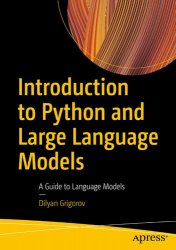Introduction to Python and Large Language Models: A Guide to Language Models
- Добавил: literator
- Дата: 27-01-2025, 02:02
- Комментариев: 0
 Название: Introduction to Python and Large Language Models: A Guide to Language Models
Название: Introduction to Python and Large Language Models: A Guide to Language ModelsАвтор: Dilyan Grigorov
Издательство: Apress
Год: 2024
Страниц: 395
Язык: английский
Формат: pdf (true), epub (true)
Размер: 10.1 MB
Gain a solid foundation for Natural Language Processing (NLP) and Large Language Models (LLMs), emphasizing their significance in today’s computational world. This book is an introductory guide to NLP and LLMs with Python programming.
The book starts with the basics of NLP and LLMs. It covers essential NLP concepts, such as text preprocessing, feature engineering, and sentiment analysis using Python. The book offers insights into Python programming, covering syntax, data types, conditionals, loops, functions, and object-oriented programming. Next, it delves deeper into LLMs, unraveling their complex components.
You’ll learn about LLM elements, including embedding layers, feedforward layers, recurrent layers, and attention mechanisms. You’ll also explore important topics like tokens, token distributions, zero-shot learning, LLM hallucinations, and insights into popular LLM architectures such as GPT-4, BERT, T5, PALM, and others. Additionally, it covers Python libraries like Hugging Face, OpenAI API, and Cohere. The final chapter bridges theory with practical application, offering step-by-step examples of coded applications for tasks like text generation, summarization, language translation, question-answering systems, and chatbots.
In the end, this book will equip you with the knowledge and tools to navigate the dynamic landscape of NLP and LLMs.
Chapter 1, “Evolution and Significance of Large Language Models,” lays the foundation. It’s here we start our journey, unraveling the complex yet fascinating world of natural language processing (NLP) and large language models. With over 50 pages dedicated to setting the stage, this chapter aims to provide the reader with a solid understanding of the evolution, significance, and basic concepts underpinning LLMs. Through a meticulous exploration of topics such as text preprocessing, word embeddings, and sentiment analysis, we uncover the magic and mechanics of LLMs and their impact across various domains.
Chapter 2, “What Are Large Language Models?”, shifts the focus to the tools that make working with LLMs possible, with a particular emphasis on “Python and Why Python for LLMs?” It demystifies Python – a language synonymous with simplicity and power in the world of programming. From basic syntax to the nuanced features of Python 3.11, readers will gain the necessary knowledge to navigate the subsequent chapters and harness Python for their LLM endeavors.
In Chapter 3, “Python for LLMs,” we plunge into the heart of LLMs, dissecting their components and understanding their workings. This chapter covers everything from embedding layers to attention mechanisms, providing insights into the technical makeup of models like GPT-4, BERT, and others. It’s a chapter designed to equip readers with a profound understanding of how LLMs predict the next token, learn from few examples, and, occasionally, hallucinate.
Chapter 4, “Python and Other Programming Approaches,” is a practical guide to leveraging Python for LLM development.
...
Chapter 7 explores how Python 3.11 and libraries such as LangChain, Hugging Face, and others are utilized to develop applications powered by large language models
(LLMs).
What You’ll Learn:
Understand the basics of Python and the features of Python 3.11
Explore the essentials of NLP and how do they lay the foundations for LLMs.
Review LLM components.
Develop basic apps using LLMs and Python.
Who This Book Is For:
Data analysts, AI and Machine Learning Experts, Python developers, and Software Development Professionals interested in learning the foundations of NLP, LLMs, and the processes of building modern LLM applications for various tasks.
Скачать Introduction to Python and Large Language Models: A Guide to Language Models
[related-news] [/related-news]
Внимание
Уважаемый посетитель, Вы зашли на сайт как незарегистрированный пользователь.
Мы рекомендуем Вам зарегистрироваться либо войти на сайт под своим именем.
Уважаемый посетитель, Вы зашли на сайт как незарегистрированный пользователь.
Мы рекомендуем Вам зарегистрироваться либо войти на сайт под своим именем.
